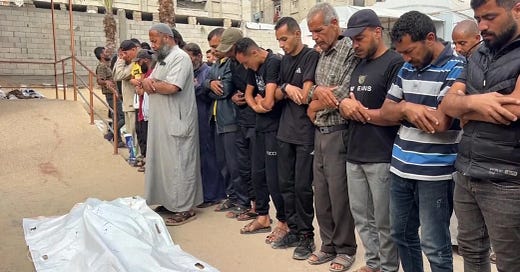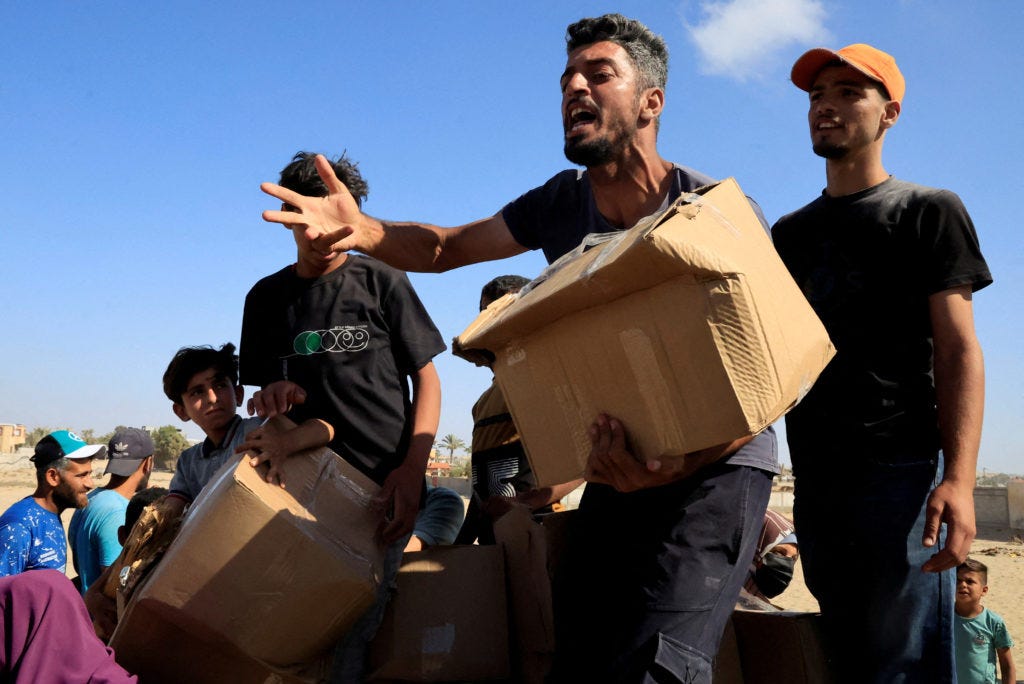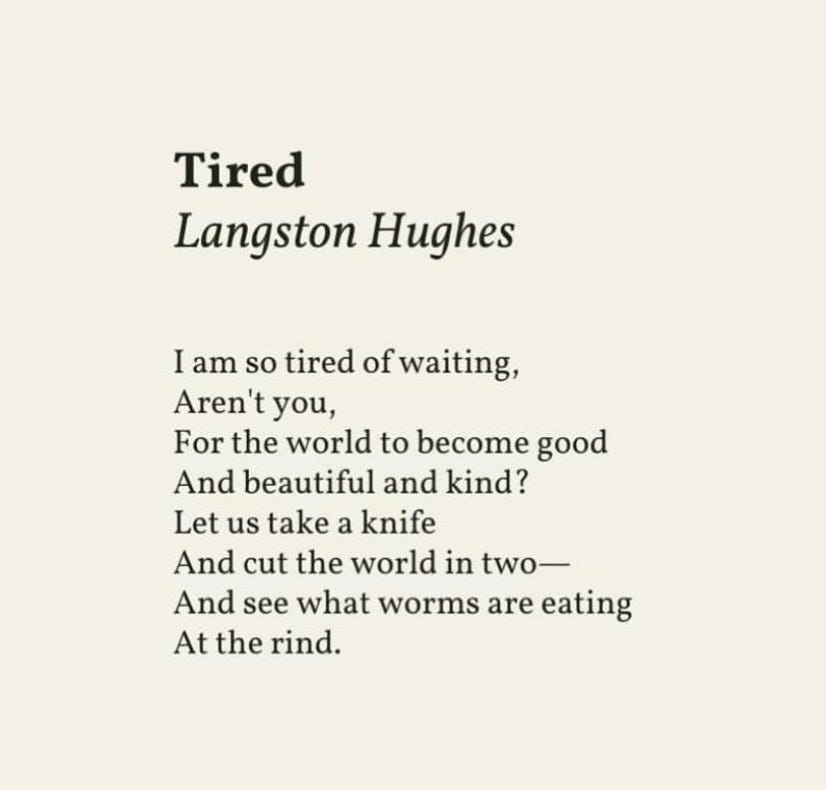How to Kill 2 Million People and Call It "Humanitarian Aid"
How the World's 'Humanitarian Response' Became the Final Phase of Palestinian Genocide
The morning Abu Tamer walked toward what he believed was salvation, the sun rose over a landscape that had been transformed into something unrecognizable. Where once orange groves stretched toward the horizon, now only twisted metal and concrete dust remained. He had heard the whispers spreading through the camps: food trucks were finally coming after three months of nothing. His five children had been surviving on whatever scraps they could find in the rubble. He kissed his wife goodbye and stepped into what would become his final day.
This is how empires kill in the modern age. Not with gas chambers or firing squads, though those tools remain in use, but with the calculated perversion of mercy itself. They starve you first, then offer salvation with conditions that strip away everything that makes you human. They document your degradation for the world to see, calling it humanitarian assistance while counting the calories needed to keep you alive but never whole.
For nearly two years, Gaza has endured what can only be described as a live-streamed genocide. Over 55,000 Palestinians have been killed, with thousands more buried beneath the rubble of what were once thriving neighborhoods. Every hospital in Gaza has been bombed or rendered inoperable, leaving doctors to perform amputations on children without anesthesia in makeshift clinics. More than 220 journalists have been systematically assassinated, their cameras silenced to prevent the world from witnessing the full scope of the carnage.
The systematic destruction extends far beyond human casualties. All 12 of Gaza's universities have been reduced to rubble, erasing decades of academic achievement and intellectual heritage. Over 800 schools that once educated half a million children now lie in ruins. More than 220 mosques and 17 churches have been destroyed, obliterating places of worship that anchored Palestinian spiritual and community life. The territory's entire electrical grid has been destroyed, along with every water treatment facility, leaving 97 percent of Gaza's water unfit for consumption.
But these final months have revealed something even more sinister: the transformation of aid into a weapon more precise than any missile. When Israeli forces completely sealed Gaza's borders in early March 2025, they created a laboratory for testing how long two million people could survive without food, medicine, or hope in a territory where 90 percent of the population has been displaced and 80 percent of all buildings have been damaged or destroyed.
The answer, it turns out, is exactly long enough to engineer the perfect trap.
The Gaza Humanitarian Foundation emerged from this engineered crisis like a mirage in the desert. American officials spoke of revolutionary new approaches to aid delivery, free from the complications of local governance or international bureaucracy. What they built instead were facilities that resembled nothing so much as livestock processing centers, complete with metal chutes, surveillance cameras, and armed guards trained to manage desperate crowds.
When the foundation's own director resigned just days before the first major distribution, his departure letter spoke of principles that could not be maintained. He meant dignity, though he could not say so directly. You cannot preserve human dignity while forcing mothers to crawl through metal cages for food. You cannot maintain neutrality while coordinating with the army that bombed the schools where these same mothers once taught their children.
The collapse was as predictable as sunrise. Thousands of Palestinians, weakened by months of starvation, rushed toward the promise of food only to meet gunfire from panicked contractors. Helicopters circled overhead, their rotors drowning out the screams below. Within hours, what had been marketed as Gaza's salvation became another scene of mass casualties, another day ending with more bodies to bury in the sand.
But the true violence lay not in the shooting but in the arithmetic. Eight thousand food boxes delivered after three months of total blockade. The United Nations had calculated that Gaza needed at least 500 trucks daily even during peacetime. After twelve weeks of complete deprivation, the need had multiplied exponentially. Eight thousand boxes for two million people equals roughly one meal for every 250 Palestinians. The mathematics of slow death, calculated to the calorie.
This is what colonial mathematics looks like: just enough aid to prevent international outcry, never enough to sustain actual life. The boxes themselves told the story. No fresh vegetables that might restore health. No seeds that could grow into future harvests. No tools for rebuilding what bombs had destroyed. Only processed meals designed to keep bodies functioning while spirits withered.
The system's cruelty extended beyond mere quantities. Distribution centers were designed as theaters of humiliation, forcing Palestinians to submit to biometric scanning, strip searches, and hours of waiting in desert heat. Those who managed to reach the front of the lines often found the aid already depleted, the trucks mysteriously empty despite promises of abundance.
Meanwhile, Israeli forces continued their systematic destruction of Gaza's capacity for self-sufficiency. All 12 of Gaza's universities have been bombed into rubble, along with over 800 schools that once educated half a million children. The territory's entire electrical grid has been destroyed, leaving no power for the water treatment plants that once served two million people. Farmers attempting to tend whatever crops had survived the bombing were shot by snipers. The few remaining olive trees, some centuries old, were burned or bulldozed. Over 95 percent of Gaza's agricultural land was rendered unusable, ensuring that even after the killing stopped, Palestinians would remain dependent on their killers for survival.
This destruction follows a deliberate pattern designed to make Gaza uninhabitable. Every water well has been contaminated or destroyed. The territory's only cancer hospital was bombed three separate times. Sewage treatment facilities were targeted, creating a public health catastrophe that threatens to kill more Palestinians than bombs. Over 400 aid workers have been murdered, making Gaza the deadliest place in the world for humanitarian personnel.
This dependency was no accident but the culmination of a project that began in 1948. Before the Nakba, Palestine fed itself and exported surplus to the region. Palestinian farmers grew citrus that reached European tables, crafted soap that was traded across the Mediterranean, manufactured glass that reflected the ancient light of their homeland. They were not rich, but they were whole, deriving their dignity (karamah) from their ability to sustain their families from their own land.
The mass expulsion of 1948 transformed landowners into refugees, turning a self-sufficient society into one dependent on international charity within two years. By 1950, former farmers were lining up for UNRWA rations, their orange groves now feeding someone else's children. This was not an unfortunate side effect of war but a deliberate strategy designed to break Palestinian capacity for independence and replace it with permanent need for charity administered by their dispossessors.
What happened in Gaza these past months was the perfection of that original crime. Create the crisis, then manage its consequences. Fund the violence that generates refugees, then fund the camps that warehouse them. Provide just enough aid to prevent complete collapse while ensuring that escape remains impossible.
The United States, which became UNRWA's largest donor, simultaneously provided 80 percent of the weapons that made aid necessary in the first place. This was not contradiction but strategy. Humanitarian aid became the perfect cover for genocide, allowing perpetrators to claim concern for Palestinian welfare while systematically destroying Palestinian capacity for independence.
The killing of journalists reveals the genocide's architects understood that documentation equals accountability. When reporters like Shireen Abu Akleh and dozens of others were systematically targeted, it was not random violence but strategic silencing. The destruction of Gaza's media infrastructure, including all television and radio stations, was designed to create an information blackout that would allow mass killing to proceed without witness. This is why over 180 Palestinian journalists have been murdered since October 2023, more than in any conflict in recorded history.
Yet something else emerged from this carefully orchestrated horror. In refugee camps across Gaza, Palestinians organized their own mutual aid networks, sharing whatever scraps they could find. Grandmothers told stories to distract children from hunger. Teachers continued lessons using charcoal on broken concrete. Doctors operated without anesthesia, refusing to abandon their patients even as their hospitals crumbled around them.
This is sumud, the Palestinian concept of steadfast perseverance rooted in the Arabic understanding of dignity as karamah, which encompasses not just individual worth but collective honor, resistance, and the refusal to surrender one's humanity. Sumud has sustained a people through 77 years of attempted erasure. It means remaining rooted when the world conspires to uproot you. It means planting olive trees in the shadow of settlements, teaching children the names of villages that exist now only in memory, refusing to accept that survival requires abandoning dignity.
Palestinian karamah is deeply connected to their land, their ability to provide for their families, their right to live with honor rather than as permanent supplicants. Before 1948, Palestinian dignity was tied to self-sufficiency, to the orange groves that stretched toward the horizon, to the ancient olive trees that connected them to their ancestors. The systematic destruction of this productive capacity was designed not just to create physical dependency but to attack the very core of Palestinian identity.
Abu Tamer's wife buried him with her bare hands, then returned to care for their five children. She did not curse the aid workers or the soldiers or the politicians who had turned her husband's hunger into his death sentence. She simply endured, as Palestinian women have endured for generations, carrying forward the life that others sought to extinguish.
This is what terrifies colonizers most: not Palestinian anger but Palestinian persistence, not their desperation but their refusal to disappear. Every child born in the camps becomes proof that genocide has failed. Every song sung in the rubble announces that culture survives conquest. Every dawn that finds Palestinians still breathing becomes an act of resistance.
The genocide's architects miscalculated something fundamental about human nature. They believed that sufficient suffering would break Palestinian attachment to their land, that enough humiliation would convince a people to choose exile over endurance. They forgot that dignity cannot be distributed in aid packages or withdrawn through blockades. It lives in the choice to remain human when the world treats you as less than human.
Tomorrow, June 12, thousands will join the Global March to Gaza, walking across continents to break the siege with their bodies and their voices. Organizations like HEAL Palestine work to provide medical aid that preserves rather than destroys Palestinian dignity. Every donation becomes an investment in sumud. Every march becomes a declaration that Palestinian life matters. Every refusal to look away becomes an act of solidarity with a people who have never stopped believing in their own worth.
The final chapter of Gaza's genocide will not be written by its architects but by those who survived it. In every Palestinian child who learns to read despite the bombing of schools, in every farmer who plants seeds in poisoned soil, in every grandmother who passes down the keys to houses that no longer exist, we see the future they could not destroy.
Palestine will be free not because the world finally develops a conscience, but because Palestinians never stopped insisting on their right to exist with dignity. This is the power of sumud: it transforms survival into victory, endurance into resistance, hope into an unstoppable force for liberation.








My favorite part: "This is what terrifies colonizers most: not Palestinian anger but Palestinian persistence, not their desperation but their refusal to disappear. Every child born in the camps becomes proof that genocide has failed. Every song sung in the rubble announces that culture survives conquest. Every dawn that finds Palestinians still breathing becomes an act of resistance."
Gaza showed us the real disgusting face of the world esp the western. Im so sorry that we cannot erase this world of evil fascists